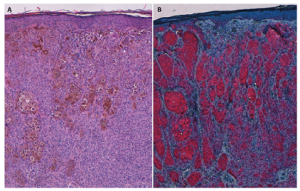Additional symptoms
Complications

Picture: Pellegrini et al. Acta Derm Venereol 2020; 100: adv00040
What is the risk of melanoma (skin cancer)?
The risk of melanoma seems to be not or only slightly elevated in smaller congenital moles (under 20 cm in size in adulthood) compared to the general population (<1%).
In patients with large congenital moles (more than 20 cm in size in adulthood), the risk of melanoma is 2-3%.
Most melanomas appear to occur in large moles with an expected size of more than 40 cm in adulthood. Melanoma can be found in both the skin and the central nervous system and can sometimes spread to other locations in the body.
Children with a congenital mole with an expected size of more than 60 cm in adulthood seem to have an increased risk.
However, there is still insufficient data available on the exact extent of this risk.
What neurological complications can occur with a congenital melanocytic naevus?
Not only can nevus cells be present in the skin, but they can also be present in the central nervous system in the case of a congenital mole.
When nevus cells are present in the central nervous system (neurocutaneous melanosis), there is a risk of neurological symptoms, such as hydrocephalus, epilepsy, or neurological deficits.
The risk of neurocutaneous melanosis with a severe course seems to be around 2% in patients with a mole with an expected size of >20 cm in adulthood. In patients with more extensive congenital moles (>40 cm in adulthood, multiple smaller CMNs), this risk is higher, but it is not possible to provide a specific number based on current literature.
Patients with CMN can also have melanocytic deposits in the central nervous system, which may or may not cause symptoms (neurocutaneous melanocytosis), and may or may not lead to serious complications. Severe complications of NCM include progressive leptomeningeal melanocytosis and primary melanoma in the central nervous system.
The course of NCM can be mild and stable, but it can also lead to progressive neurological disease, often with a fatal outcome in the latter case. It is of utmost importance to detect neurological symptoms early to initiate appropriate management in a timely manner.
